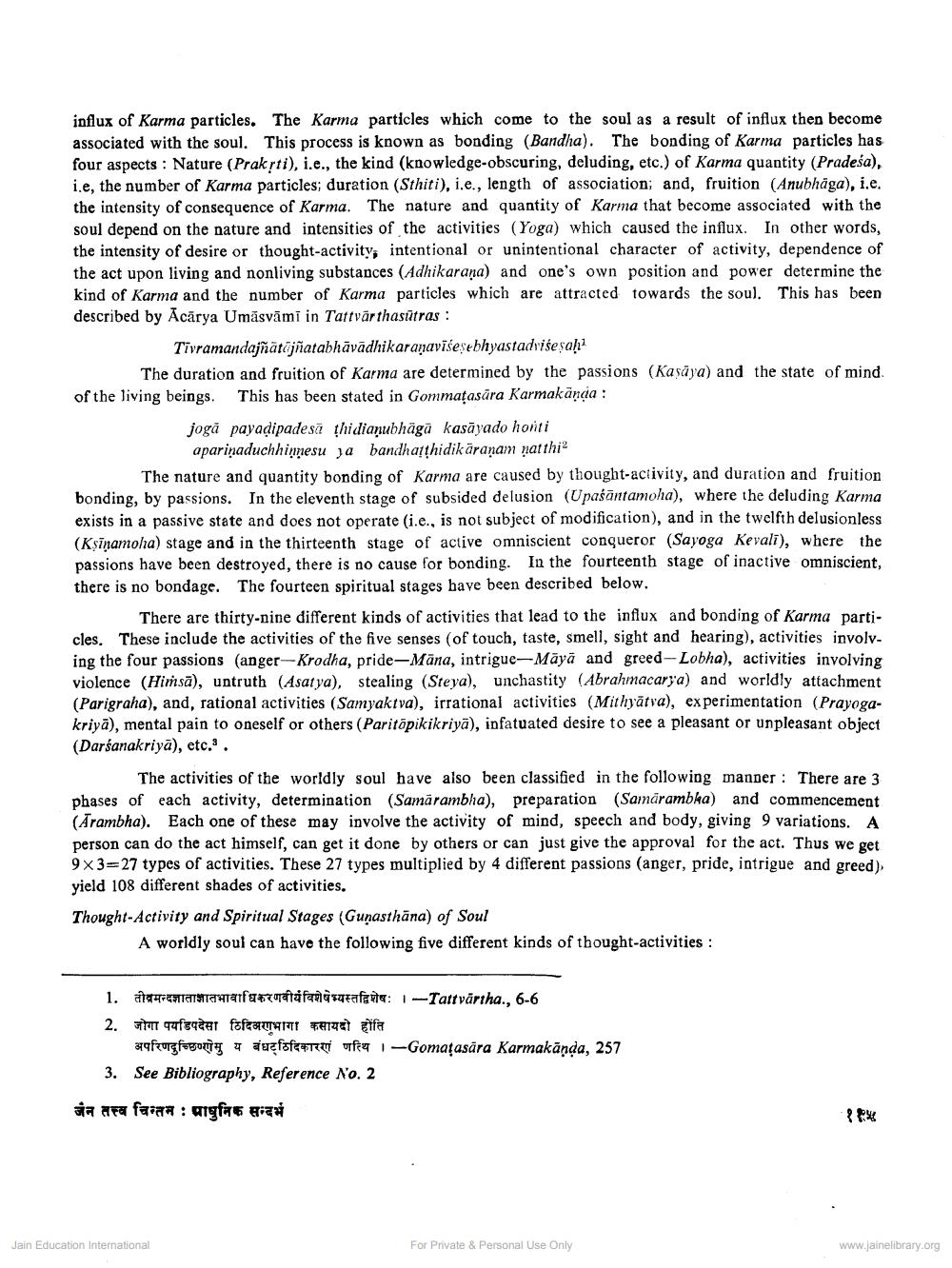Book Title: How Karma theory relates to Modern Science Author(s): Dulichand Jain Publisher: Z_Deshbhushanji_Maharaj_Abhinandan_Granth_012045.pdf View full book textPage 4
________________ influx of Karma particles. The Karma particles which come to the soul as a result of influx then become associated with the soul. This process is known as bonding (Bandha). The bonding of Karma particles has four aspects : Nature (Prakrti), i.e., the kind (knowledge-obscuring, deluding, etc.) of Karma quantity (Pradeśa), i.e, the number of Karma particles; duration (Sthiti), i.e., length of association; and, fruition (Anubhäga), i.e. the intensity of consequence of Karma. The nature and quantity of Karma that become associated with the soul depend on the nature and intensities of the activities (Yoga) which caused the influx. In other words, the intensity of desire or thought-activity, intentional or unintentional character of activity, dependence of the act upon living and nonliving substances (Adhikarana) and one's own position and power determine the kind of Karma and the number of Karma particles which are attracted towards the soul. This has been described by Acārya Umāsvāmi in Tattvärthasūtras : Tivramandajñātājñatabhāvādhikaranavišeşebhyastadriše şah The duration and fruition of Karma are determined by the passions (Kasāya) and the state of mind. of the living beings. This has been stated in Gommațasāra Karmakānda: jogă payadipadesă țhidianubhāgā kasāyado honti aparinaduchhimesu ja bandhatthidikāraṇam natthie The nature and quantity bonding of Karma are caused by thought-activity, and duration and fruition bonding, by passions. In the eleventh stage of subsided delusion (Upaśāntamoha), where the deluding Karma exists in a passive state and does not operate (i.e., is not subject of modification), and in the twelfth delusionless (Kșīnamoha) stage and in the thirteenth stage of active omniscient conqueror (Sayoga Kevali), where the passions have been destroyed, there is no cause for bonding. In the fourteenth stage of inactive omniscient, there is no bondage. The fourteen spiritual stages have been described below. There are thirty-nine different kinds of activities that lead to the influx and bonding of Karma particles. These include the activities of the five senses (of touch, taste, smell, sight and hearing), activities involving the four passions (anger-Krodha, pride-Māna, intrigue-Mäyä and greed-Lobha), activities involving violence (Hiṁsā), untruth (Asatya), stealing (Steya), unchastity (Abrahmacarya) and worldly attachment (Parigraha), and, rational activities (Samyaktva), irrational activities (Mithyātva), experimentation (Prayogakriyā), mental pain to oneself or others (Paritõpikikriyā), infatuated desire to see a pleasant or unpleasant object (Darśanakriya), etc.. The activities of the worldly soul have also been classified in the following manner: There are 3 phases of each activity, determination (Samārambha), preparation (Samārambha) and commencement (Ārambha). Each one of these may involve the activity of mind, speech and body, giving 9 variations. A person can do the act himself, can get it done by others or can just give the approval for the act. Thus we get 9x3=27 types of activities. These 27 types multiplied by 4 different passions (anger, pride, intrigue and greed) yield 108 different shades of activities. Thought-Activity and Spiritual Stages (Gunasthāna) of Soul A worldly soul can have the following five different kinds of thought-activities : 1. P engerafortfarasurafia: 1-Tattvärtha., 6-6 2. जोगा पयडिपदेसा ठिदिअणुभागा कसायदो होति fargfogott y suffemati of I-Gomaļasāra Karmakānda, 257 3. See Bibliography, Reference No. 2 जैन तस्व चिन्तन : प्राधुनिक सन्दर्भ Jain Education International For Private & Personal Use Only www.jainelibrary.orgPage Navigation
1 2 3 4 5 6 7 8 9 10 11
